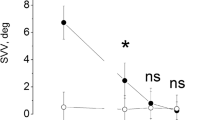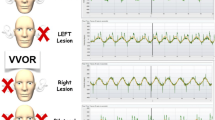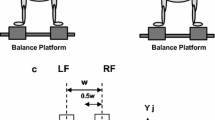Abstract
The vestibulo-ocular reflex (VOR) was studied in nine human subjects 2–15 months after permanent surgical occlusion of one posterior semicircular canal. The stimuli used were rapid, passive, unpredictable, low-amplitude (10–20°), high-acceleration (3000–4000°/s2) head rotations in pitch and yaw planes. The responses measured were vertical and horizontal eye rotations, and the results were compared with those from 19 normal subjects. After unilateral occlusion of the posterior semi-circular canal, the gain of the head-up pitch vertical VOR — the vertical VOR generated by excitation from only one and disfacilitation from two vertical semicircular canals — was reduced to 0.61±0.06 (normal 0.92±0.06) at a head velocity of 200°/s. In contrast the gain of the head-down pitch vertical VOR — the VOR still generated by excitation from two, but disfacilitation from only one vertical semicircular canal — was within normal limits: 0.86±0.11 (normal 0.96±0.04). The gain of the horizontal VOR in response to yaw head rotations — ipsilesion 0.81±0.06 (normal 0.88±0.05) and contralesion 0.80±0.11 (normal 0.92±0.11) — was within normal limits in both directions (group means ± two-tailed 95% confidence intervals given in each case). These results show that occlusion of just one vertical semicircular canal produces a permanent deficit of about 30% in the vertical VOR gain in response to rapid pitch head rotations in the excitatory direction of the occluded canal. This observation indicates that, in response to a stimulus in the higher dynamic range, compensation of the human VOR for the loss of excitatory input from even one vertical semicircular canal is incomplete.
Similar content being viewed by others
References
Aw ST, Halmagyi GM, Curthoys IS, Todd MJ, Yavor RA (1994) Unilateral vestibular deafferentation causes permanent impairment of the human vertical vestibulo-ocular reflex in the pitch plane. Exp Brain Res 102: 121–130
Bahill AT, Kallman JS, Lieberman JE (1982) Frequency limitations of the two-point central difference differentiation algorithm. Biol Cybern 45: 1–4
Barmack NH, Pettorossi VE (1988) The induction and compensation of asymmetric eye movements following unilateral blockage of a horizontal semicircular canal in the rabbit. J Neurosci8: 2836–2843
Becker RA, Chambers JM, Wilks AR (1988) The new S language. A programming environment for data analysis and graphics. (Computer science series) AT&T Bell Laboratories, Wadsworth & Brooks/Cole, Pacific Grove, Calif
Böhmer A, Henn V, Suzuki JI (1985) Vestibulo-ocular reflexes after selective plugging of the semicircular canals in the monkey — response plane determinations. Brain Res 326: 291–298
Bronstein AM, Hood JD (1986) The cervico-ocular reflex in normal subjects and patients with absent vestibular function. Brain Res 373: 399–408
Carl JR, Gellman RS (1987) Human smooth pursuit: stimulus-dependent responses. J Neurophysiol 57: 1446–1463
Cleveland WS (1979) Robust locally weighted regression and smoothing scatterplots. J Am Stat Assoc 74: 829–836
Collewijn H, Martins AJ, Steinman RM (1983) Compensatory eye movements during active and passive head movements: fast adaptation to changes in visual magnification. J Physiol (Lond) 340: 259–286
Foster CA, Foster BD, Spindler J, Harris JP (1994) Functional loss of the horizontal doll's eye reflex following unilateral vestibular lesions. Laryngoscope 104: 473–478
Goldberg JM, Fernández C (1975) Responses of peripheral vestibular neurons to angular and linear accelerations in the squirrel monkey. Acta Otolaryngol 80: 101–110
Halmagyi GM, Curthoys IS, Cremer PD, Henderson CJ, Todd MJ, Staples MJ, D'Cruz DM (1990) The human horizontal vestibulo-ocular reflex in response to high-acceleration stimulation before and after unilateral vestibular neurectomy. Exp Brain Res 81: 479–490
Istl-Lenz Y, Hyden D, Schwarz DWF (1985) Response of the human vestibuloocular reflex following long-term 2x magnified visual input. Exp Brain Res 57: 448–455
Lisberger SG (1988) The neural basis for motor learning in the vestibulo-ocular reflex in monkeys. Trends Neurosci 11: 147–152
Melvill-Jones G, Segal B, Katsarkas A, Bloomberg J (1988) Experiments on vestibular adaptation and its clinical significance. In:. Barber HO, Sharpe JA (eds) Vestibular disorders. Year Book Medical Publishers, Chicago
Minor LB, Goldberg JM (1990) Influence of static head position on the horizontal nystagmus evoked by caloric, rotational and optokinetic stimulation in the squirrel monkey. Exp Brain Res82: 1–13
Money KE, Scott JW (1962) Functions of separate sensory receptors of nonauditory labyrinth of the cat. Am J Physiol 202: 1211–1220
Paige GD (1983) Vestibuloocular reflex and its interactions with visual following mechanisms in the squirrel monkey. II. Response characteristics and plasticity following unilateral inactivation of horizontal canal. J Neurophysiol 49: 152–168
Parnes LS, McClure JA (1991) Posterior semicircular canal occlusion in the normal hearing ear. Otolaryngol Head Neck Surg 104: 52–57
Pulaski PD, Zee DS, Robinson DA (1981) The behavior of the vestibulo-ocular reflex at high velocities of head rotation. Brain Res 222: 159–165
Robinson DA (1963) A method of measuring eye movement using a scleral search coil in a magnetic field. IEEE Trans Biomed Eng 10: 137–145
Simpson JI, Graf W (1985) The selection of reference frames by nature and its investigators. In: Berthoz A, Melvill-Jones G (eds) Adaptive mechanisms in gaze control. Elsevier Science, New York, pp 3–16
Vibert N, Waele C de, Escudero M, Vidal PP (1993) The horizontal vestibulo-ocular reflex in the hemilabyrinthectomized guinea-pig. Exp Brain Res 97: 263–273
Winer BJ, Brown DR, Michels KM (1991) Statistical principles in experimental design, 3rd edn. McGraw-Hill, New York
Author information
Authors and Affiliations
Corresponding author
Rights and permissions
About this article
Cite this article
Aw, S.T., Halmagyi, G.M., Pohl, D.V. et al. Compensation of the human vertical vestibulo-ocular reflex following occlusion of one vertical semicircular canal is incomplete. Exp Brain Res 103, 471–475 (1995). https://doi.org/10.1007/BF00241506
Received:
Accepted:
Issue Date:
DOI: https://doi.org/10.1007/BF00241506




